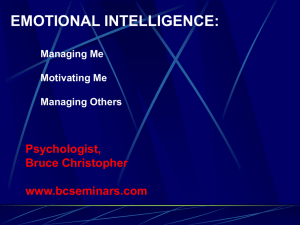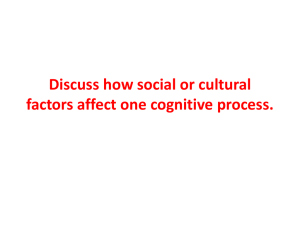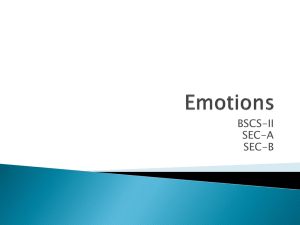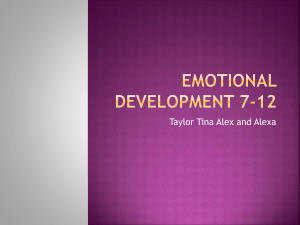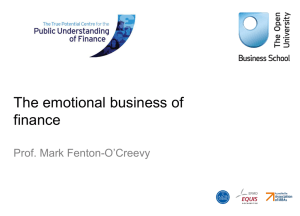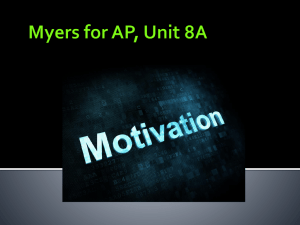a PowerPoint Presentation of Module 35
advertisement
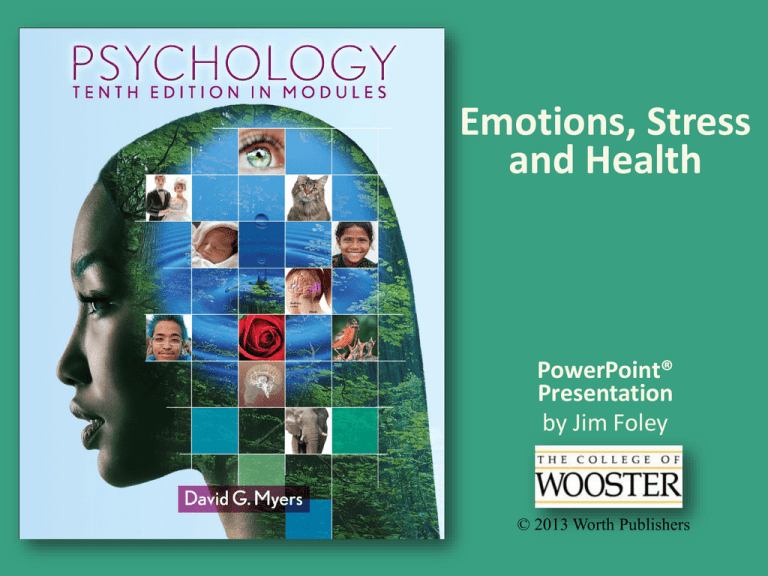
Emotions, Stress and Health PowerPoint® Presentation by Jim Foley © 2013 Worth Publishers Module 35: Introduction to Emotion Emotion: Arousal, Behavior, and Cognition Someone cuts you off on the road. You may feel the emotion of anger. Emotions are a mix of: Expressive behavior: yelling, accelerating Bodily arousal: sweat, pounding heart Conscious experience: (thoughts, especially the labeling of the emotion) What a bad driver! I am angry, even scared; better calm down. How do these components of emotion interact and relate to each other? Do our thoughts trigger our emotions, or are they a product of our emotions? How are the bodily signs triggered? How do we decide which emotion we’re feeling? An emotion is a full body/mind/behavior response to a situation. Theories of Emotion: The Arousal and Cognition “Chicken and Egg” Debates Which came first, the chicken or the egg? Or did they evolve together? Which happens first, the body changes that go with an emotion, or the thoughts (conscious awareness and labeling of an emotion), or do they happen together? James-Lange Theory: • body before thoughts Cannon-Bard Theory: • body with thoughts Singer-Schachter/Twofactor theory: • body plus thoughts/label Zajonc, LeDoux, Lazarus: • body/brain without conscious thoughts James-Lange Theory: Body Before Thoughts William James (1842-1910): “We feel afraid because we tremble, sorry because we cry.” The James-Lange theory states that emotion is our conscious awareness of our physiological responses to stimuli. Our body arousal happens first, and then the cognitive awareness and label for the feeling: “I’m angry.” According to this theory, if something makes us smile, we may then feel happy. Cannon-Bard Theory: Simultaneous Body Response and Cognitive Experience The Cannon-Bard theory asserts that we have a conscious/cognitive experience of an emotion at the same time as our body is responding, not afterward. Human body responses run parallel to the cognitive responses rather than causing them. Adjusting the Cannon-Bard Theory Emotions are not just a separate mental experience. When our body responses are blocked, emotions do not feel as intense. Our cognitions influence our emotions in many ways, including our interpretations of stimuli: “Is that a threat? Then I’m afraid.” Schachter-Singer “Two-factor” Theory: Emotion = Body Plus a Cognitive Label The Schachter-Singer “two-factor” theory suggests that emotions do not exist until we add a label to whatever body sensations we are feeling. I face a stranger, and my heart is pounding. Is it fear? Excitement? Anger? Lust? Or did I have too much caffeine? The label completes the emotion. In a study by Stanley Schachter and Jerome Singer in 1962, subjects experienced a spillover effect when arousal was caused by injections of what turned out to be adrenaline. The subjects interpreted their agitation to whatever emotion the others in the room appeared to be feeling; the emotional label “spilled over” from others. Which theory would suggest that you experience the emotion of anger at the same time that your heart begins to beat rapidly? A. B. C. D. James-Lange theory Cannon-Bard theory two-factor theory adaptation-level phenomenon If people who have just been aroused by watching rock videos are insulted, their feelings of anger will be greater than those of people who have been similarly provoked but were not previously aroused. This is best explained by the: A. B. C. D. relative deprivation principle. adaptation-level principle. catharsis hypothesis. two-factor theory. When Mr. Morgan began to misinterpret his harmless symptoms of autonomic nervous system arousal as indicative of an impending heart attack, he suffered an unusually intense level of fear. His emotional suffering is best understood in terms of the: A. B. C. D. catharsis hypothesis. James-Lange theory. adaptation-level theory. two-factor theory. Robert Zajonc, Joseph LeDoux, and Richard Lazarus: Emotions without Awareness/Cognition Theory: some emotional reactions, especially fears, likes, and dislikes, develop in a “low road” through the brain, skipping conscious thought. In one study, people showed an amygdala response to certain images (above, left) without being aware of the image or their reaction. When Appraisal Affects Emotion Stanley Schachter and Jerome Singer highlighted the role of appraisal in labeling consciously experienced emotions: “this agitation is fear.” Richard Lazarus noted that even in emotional responses that operate without conscious thought, “top-down” cognitive functions such as appraisal of stimuli (is that a threat or something I would enjoy?) can be involved . Summary: Theories of Emotion Theories of Emotion Emotion can include the appraisal of the stimulus such as, is it a threat or not? Avoiding the highway today without identifying or explaining any fear is an example of the “low road” of emotion. Embodied Emotion: The role of the autonomic nervous system The physiological arousal felt during various emotions is orchestrated by the sympathetic nervous system, which triggers activity and changes in various organs. Later, the parasympathetic division calms down the body. basketball free throw contest. Her performance is likely to be ________ if her physiological arousal during the performance is ________. A. B. C. D. best; very low best; very high best; moderate worst; moderate Embodied Emotion: How Do Emotions Differ in Body Signs? It is difficult to see differences in emotions from tracking heart rate, breathing, and perspiration. There is also a large overlap in the patterns of brain activity across emotions. There are some small differences; for example, fear triggers more amygdala activity than anger. A general brain pattern: hemispheric differences Positive “approach” emotions (joy, love, goalseeking) correlate with left frontal lobe activity. Negative “withdrawal” emotions (disgust, fear, anger, depression) correlate with right hemisphere activity. We have all heard about a lie detector or polygraph. You have taken a lie detector test because your boss thinks someone is stealing from the office. You are innocent, but unfortunately, you are informed that you have “failed” the polygraph test. Which of the following is NOT true about these tests? A. A polygraph cannot really detect the difference between arousal caused by anxiety and that caused by lying. B. Polygraph tests can easily be fooled. C. People who pass lie detector tests are innocent, but those who fail are not necessarily guilty. D. While widely used by police and government agencies, polygraphs often fail to identify the guilty.
